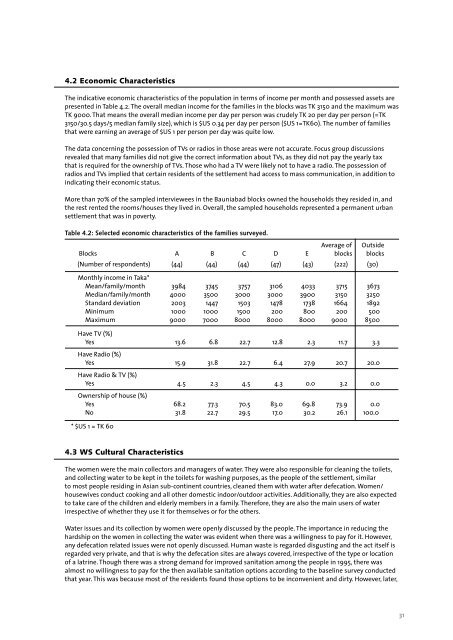Untitled - UNU-IAS - United Nations University
Untitled - UNU-IAS - United Nations University
Untitled - UNU-IAS - United Nations University
Create successful ePaper yourself
Turn your PDF publications into a flip-book with our unique Google optimized e-Paper software.
4.2 Economic Characteristics<br />
<br />
<br />
<br />
<br />
<br />
<br />
<br />
<br />
<br />
<br />
<br />
<br />
<br />
<br />
<br />
<br />
<br />
<br />
The indicative economic characteristics of the population in terms of income per month and possessed assets are<br />
presented in Table 4.2. The overall median income for the families in the blocks was TK 3150 and the maximum was<br />
TK 9000. That means the overall median income per day per person was crudely TK 20 per day per person (=TK <br />
3150/30.5 days/5 median family size), which is $US 0.34 per day per person ($US 1=TK60). The number of families <br />
<br />
<br />
<br />
<br />
that were earning an average of $US 1 per person per day was quite low. <br />
<br />
The data concerning the possession of TVs or radios in those areas were not accurate. Focus group discussions <br />
revealed that many families did not give the correct information about TVs, as they did not pay the yearly tax<br />
that<br />
<br />
is required for the ownership of TVs. Those who<br />
<br />
had a TV were<br />
<br />
likely<br />
<br />
not to have<br />
<br />
a radio. The possession of<br />
radios<br />
<br />
and TVs implied that certain residents of the<br />
<br />
settlement<br />
<br />
had access<br />
<br />
to mass<br />
<br />
communication,<br />
<br />
in addition<br />
<br />
to<br />
<br />
indicating<br />
<br />
their economic status.<br />
<br />
<br />
More<br />
<br />
than 70% of the sampled interviewees in the<br />
<br />
Bauniabad<br />
<br />
blocks<br />
<br />
owned the<br />
<br />
households<br />
<br />
they<br />
<br />
resided in,<br />
<br />
and<br />
<br />
the<br />
<br />
rest rented the rooms/houses they lived in. Overall,<br />
<br />
the<br />
<br />
sampled<br />
<br />
households<br />
<br />
represented<br />
<br />
a permanent<br />
<br />
urban<br />
<br />
settlement <br />
that was in poverty.<br />
Table 4.2: Selected economic characteristics of the families surveyed.<br />
<br />
<br />
<br />
<br />
<br />
<br />
<br />
<br />
<br />
<br />
<br />
<br />
<br />
<br />
<br />
<br />
<br />
<br />
<br />
<br />
<br />
<br />
4.3 <br />
WS Cultural Characteristics<br />
<br />
The women were the main collectors and managers of water. They were also responsible for cleaning the toilets, <br />
and collecting water to be kept in the toilets for washing purposes, as the people of the settlement, similar <br />
to most people residing in Asian sub-continent countries, cleaned them with water after defecation. Women/ <br />
housewives conduct cooking and all other domestic indoor/outdoor activities. Additionally, they are also expected<br />
to take care of the children and elderly members in a family. Therefore, they are also the main users of water<br />
irrespective of whether they use it for themselves or for the others.<br />
<br />
Water issues and its collection by women were openly discussed <br />
<br />
<br />
by the people. The importance in reducing the<br />
hardship on the women in collecting the water was evident when there was a willingness to pay for it. However,<br />
any defecation related issues were not openly discussed. Human waste is regarded disgusting and the act itself is<br />
regarded very private, and that is why the defecation sites are always covered, irrespective of the type or location<br />
of a latrine. Though there was a strong demand for improved sanitation among the people in 1995, there was<br />
almost no willingness to pay for the then available sanitation options according to the baseline survey conducted<br />
that year. This was because most of the residents found those options to be inconvenient and dirty. However, later,<br />
<br />
<br />
<br />
31
















